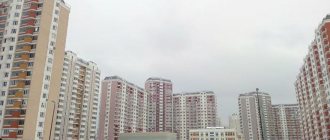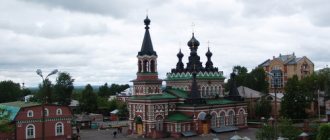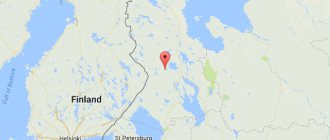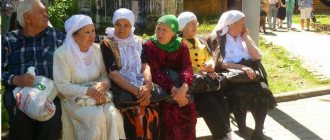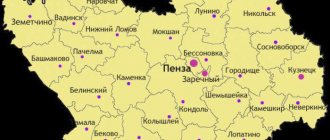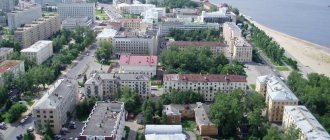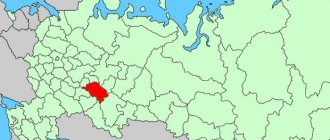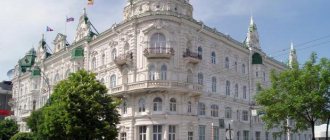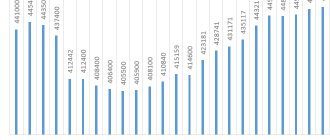Key information
The city is included in the list of settlements located in the Far North zone. Petrozavodsk is dominated by a temperate continental climate. The winter period is long and characterized by an abundance of snow. The average air temperature in the Prionezhsky region is +3 °C. The number of warm days exceeds 130. Cyclones are frequent guests in these parts. Air masses come from the west and bring with them heavy precipitation.
The hottest month is July. At the height of summer, the thermometer readings can reach +30 °C. The coldest time is January. The air temperature drops to -33 °C. The weather conditions in the region are directly influenced by the largest body of water in the Northwestern District. The city blocks are located on the shores of Lake Onega. The landscape of Petrozavodsk is cut by the beds of the rivers Tomitsa, Lososinka, Studenets, Neglinka. Some of them are navigable.
Basic information about the city
Petrozavodsk is the long-time capital of the Republic of Karelia. It is located on the shores of the legendary Lake Onega. The length of the city along the lake is 22 kilometers. The city is cut into pieces by non-navigable rivers: Neglinka, Lososinka, Tomitsa, and is surrounded by a forest belt.
Let's take a closer look at what microdistricts Petrozavodsk consists of. The population lives in several parts: Zheleznodorozhny district, Kukkovka, Vygoinavolok, Oktyabrsky district, Klyuchevoy, Silicate plant, Solomennoye, Northern industrial zone. In 1991, the official coat of arms of the city appeared. The city itself owes its appearance to Peter the Great and the events that took place in the 18th century. At this time Russia was looking for access to the Baltic Sea. Everything in the country was being rebuilt in a “European way”, Petrozavodsk was no exception.
The population was engaged in agriculture and industrial production. It was by the Decree of the Emperor that the Petrovsky plant was founded at the mouth of Lososinka, and Petrozavodsk is proud of it. At that time, the population produced various materials and decorations for the city, and the legendary Peter the Great’s fleet was built here. Petrovskaya Sloboda was founded around the plant. In the capital of Karelia, parts of historical buildings have been preserved: the architectural ensemble of the Alexander Nevsky Cathedral and the Cathedral of the Exaltation of the Cross. To this day, along Neglinka there are wooden houses that belonged to the city nobility. The war did not spare the city of Petrozavodsk. The population rebuilt it, and the city received a second life.
Demographic statistics
The population of Petrozavodsk was first established in 1723. The number of residents at that time barely reached two thousand people. At the beginning of the 19th century, the city began to actively grow and develop. In 1801, almost five thousand lived there. In 1856 there were already more than 10,000 people. Until 1992, the population of Petrozavodsk was constantly increasing. In 1993, it amounted to 279,000. This year became a turning point for the demographic situation in the region.
The years in which growth was noted alternated with periods of natural decline. Thus, in 2001, the number of residents exceeded 282,900, and in 2002 it decreased to 266,160. The population of Petrozavodsk in 2009 reached 271,112. In 2010, demographers noted a systematic increase in the number of citizens. Every year the number of residents increases by about two thousand. In 2011, 263,500 people were registered in the city. In 2012 there were already 265,263, in 2013 this figure reached 268,946.
The population of Petrozavodsk in 2022 exceeded 278,000 inhabitants. Peak birth rates occurred in the sixties of the 20th century. Today the municipality occupies the seventieth place in the all-Russian ranking. The positive dynamics that the city shows are associated not only with a reduction in deaths and an increase in the birth rate, but also with a change in the statistical accounting system.
In 2011, city residents began to include not only migrants who had obtained citizenship, but also visitors who received temporary registration for more than nine months. The population density of Petrozavodsk is 2,063 people. per square kilometer.
National composition
The city is dominated by Russians. Their share exceeds 75%. Karelians account for 9%. The municipality is considered a place of compact settlement of representatives of this ethnic group. Every fifth Karelian lives in Petrozavodsk. There is a high concentration of Vepsians in the city. This is another northern people who have lived in Karelia for centuries. The national composition of the population of Petrozavodsk is represented by five dozen ethnic groups.
These include Finns. According to statistics, their number exceeds 7,383 or 2.8%. There are about the same number of Belarusians. There are slightly fewer Ukrainians. Their number is 6,255 people or 2.3%. There are many Azerbaijanis, Armenians, Poles and Tatars. There are Gypsies, Jews, Georgians, Germans and Chuvashs.
How to get there
Petrozavodsk on the map of Russia is located approximately 1000 km north of Moscow and 400 km northeast of St. Petersburg, connected to major Russian cities by transport links of all types.
By plane
The fastest way to get to Petrozavodsk is by plane. The flight from Moscow takes 1 hour 40 minutes. There are also regular flights from St. Petersburg. There are plans to expand the terminal and launch international traffic to Helsinki.
The local airport is located 12 km from the city in the village of Besovets, which is about another 30 minutes. by car. The cost of a taxi is approximately 900 rubles. During the day you can travel by public transport for 57 rubles. The bus ride takes 45 minutes.
By train
The railway connection with Moscow is very good. Every day 7-8 trains depart from Kursky and Leningradsky stations. The fastest way to get there is in 12 hours.
The price of a reserved seat ticket is 1,600 rubles, a compartment ticket will cost 2 times more.
Petrozavodsk is easily accessible from Moscow by train.
From St. Petersburg from the Ladozhsky station the train takes 5 hours, the cost of a seated ticket will cost 1100 rubles. 5-6 trains depart daily.
By bus
You can get to Petrozavodsk in 9-10 hours by bus from St. Petersburg. Ticket price 850 rub. There are also buses to Kem, Sortavala, Belomorsk. Other regular routes from the bus station to Finland.
By car
The distance between the capitals is a little more than 1 thousand km, so it is quite possible to get from Moscow to Petrozavodsk by car in 13-15 hours. From St. Petersburg by car the trip will take about 5 hours.
A car ride around Karelia will bring great pleasure. The roads pass along pine forests, past numerous lakes and wild rivers, surrounded by picturesque rocky ridges.
Age groups
In 2010, employees of the social protection authorities of Petrozavodsk recorded three centenarians. Their age has exceeded 100 years. In total, more than 85,000 retired persons are registered on the territory of the municipal center. The average age of elderly people is 64. There are more than 6,700 people over eighty years old. There are approximately four hundred people in Petrozavodsk who are ninety years old.
The average life expectancy in Karelia is seventy years. The causes of population mortality are malignant neoplasms, pathologies of the circulatory system, and alcoholism. Doctors managed to reduce the number of maternal and child deaths. Women undergo regular medical examinations. If necessary, they are provided with financial assistance.
Way of life
The Petrozavodsk Employment Center claims that vacancies for artisans and craftsmen in the locality are always open. Embroidery on clothing and home textiles, sewing with gold threads, birch bark weaving, and wood painting are considered traditional for these places. As well as blacksmith craft, artistic carving, creating decorative elements and jewelry from dry straw.
Local craftswomen decorate clothes with pearl embroidery and weave mats and carpets. Products from local manufacturers can be purchased in museums, galleries and exhibition centers. The workshops employ a large number of ethnic minorities, as well as people with disabilities. Employees of the Petrozavodsk Employment Center note a reduction in the number of unemployed and an increase in the number of able-bodied citizens.
What to bring
The most delicious and useful common gift and souvenir can be called balm from Karelian herbs, jams and tinctures from northern berries. They are sold not only in souvenir shops, but also in supermarkets.
Petrozavodsk is also famous for its unique crafts made from rare Karelian birch wood. The most beautiful paintings, boxes, watches, souvenirs such as magnets, salt shakers and even flash drives for computers are made from it.
Karelian embroidery in red and white colors, created by craftswomen using ancient technologies, has recently become very popular.
Ornaments from geometric shapes are intricately formed into various shapes of animals, birds and people. The healing properties of shungite are known far beyond the borders of Karelia, and this is where this healing mineral is mined. You can bring unusual souvenirs or just a few black pebbles with metal veins as a souvenir and for purifying water.
Patchwork items are a common lasting gift from Petrozavodsk. This could be a quilt, potholders, tablecloth, pillowcases or blanket. You can choose elegant bright interior items of any color.
Karelian ceramics made from red local clay can become a practical souvenir of a trip to Petrozavodsk. The choice of products is very diverse: from a decorative vase to a practical pot. Everyone can choose according to their taste and budget.
Petrozavodsk is an amazing and interesting place, which, despite its remoteness on the map of Russia, is very popular with tourists from all over the country and guests of Karelia.
Article design: Oleg Lozinsky
Income
Wages in the city are thirty and sometimes fifty percent lower than in St. Petersburg. An ordinary resident of Petrozavodsk receives on average fifteen thousand rubles. However, official information states that this amount is 20,000. Over ten years, the income of the population has almost doubled. About twenty thousand companies and enterprises are registered on the territory of the municipal district.
Three plants are involved in mining. There are more than two hundred factories processing raw materials. There are more than seventy complexes involved in the production of electricity and maintenance of public utility lines.
City enterprises
In modern Petrozavodsk there are quite a lot of industrial enterprises for metalworking, mechanical engineering, vehicle production, and the forestry industry.
The “heart of Karelia” also has its own attractions that make the city attractive to guests from the Russian Federation and foreign countries. These are the foundry, the Onega Tractor Plant, the Severyanka sewing plant, the Petrozavodsk Distillery, and the shipbuilding plant. It is at these enterprises of the capital of Karelia that the vast majority of the population works.
Social infrastructure
The population of Petrozavodsk has at its disposal kindergartens, secondary schools, colleges, branches of higher educational institutions, outpatient and hospital complexes. There are about twenty square meters of comfortable housing per resident of the municipal center. The number of operating preschool institutions exceeds 66. They educate more than 12,000 children.
Enrollment of children in educational institutions is 82%. The number of secondary schools is constantly increasing. According to official data, there are more than 46 municipal facilities. About 30,000 people study there. Medical institutions are represented by clinics, sanatoriums, outpatient clinics, dispensaries and hospitals. They employ about 2,500 doctors. The number of nursing staff exceeds 4,000.
Fifteen hospital complexes provide 3,500 beds. Each outpatient facility is designed to provide medical care to 7,000 Petrozavodsk residents. Law enforcement agencies record 7,000 crimes annually. For each attacker, there are approximately three episodes of violation of the law.
Opportunities and prospects
Petrozavodsk is acquiring new multi-storey microdistricts. Improving the quality of life attracts qualified personnel and young people to the region. Every year more than sixty thousand square meters of modern housing are put into operation. Builders report that the number of apartments they have delivered has almost reached 1,000.
The city's population is served by public transport. There are five municipal routes. Every year, urban transport operators serve about five million passengers. All major cellular companies in Russia provide their services on the territory of the municipality. In addition to voice communication, they offer high-speed Internet access.


